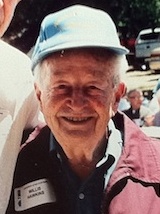Willis Hawkins
Willis Moore Hawkins (born December 1, 1913 in Kansas City (Missouri) , † September 28, 2004 in Woodland Hills , California) was an American aerospace engineer with Lockheed . He led the development team for the Lockheed C-130 Hercules transport aircraft .
Hawkins studied aircraft engineering at the University of Michigan with a bachelor's degree in 1937. In the same year he went to Lockheed. From 1941 to 1947 he was manager of the Preliminary Design Department and headed it from 1947 to 1952. In 1951, he headed the design team for the Model 82, which then became the Hercules. 1954 to 1957 he was chief engineer (Director of Engineering) of the Missiles and Space Division (rockets, space travel), 1957 to 1960 its Assistant General Manager and then to 1962 its General Manager. At that time, among other things, the Polaris missiles for the US Navy were developed under his leadership . In 1960 he became Vice President at Lockheed, responsible for research and development. From 1963 to 1966 he was Assistant Secretary for Research and Development of the US Army (during this time, among other things, the M1 Abrahams tank was launched). He then returned to Lockheed as Corporate Senior Vice President (from 1969). 1972 to 1980 he was on the Supervisory Board of Lockheed (Board of Directors). In 1974 he retired early and was called back to temporarily head the California department from 1976 to 1979. In 2004, he saw the celebrations of the 50th anniversary of the Hercules' first flight (23 August 1954).
In addition to the Hercules, he was involved in the development of the Lockheed Constellation , the Lockheed P-80 Shooting Star, the Lockheed XF-90 , the Lockheed F-94 Starfire and the Lockheed F-104 Starfighter. The Shooting Star was the first jet aircraft to be used by the US Air Force . A Lockheed jet fighter project started during World War II (from 1939) - the L-133 , which Hawkins was involved in developing - was rejected by the US Air Force as being too advanced.
In 1963 he received honorary degrees from the University of Michigan and in 1966 from Illinois College. In 1988 he received the National Medal of Science and in 1961 the US Navy Distinguished Public Service Medal. He was a member of the National Academy of Engineering and a Fellow of the Royal Aeronautical Society and the American Institute of Aeronautics and Astronautics .
Web links
Individual evidence
- ↑ http://www.oac.cdlib.org/findaid/ark:/13030/c8ms3rgj/admin/#bioghist-1.2.3
- ↑ Life data according to American Men and Women of Science , Thomson Gale 2004
| personal data | |
|---|---|
| SURNAME | Hawkins, Willis |
| ALTERNATIVE NAMES | Hawkins, Willis Moore |
| BRIEF DESCRIPTION | American engineer |
| DATE OF BIRTH | December 1, 1913 |
| PLACE OF BIRTH | Kansas City (Missouri) |
| DATE OF DEATH | September 28, 2004 |
| Place of death | Woodland Hills (Los Angeles) , California |
